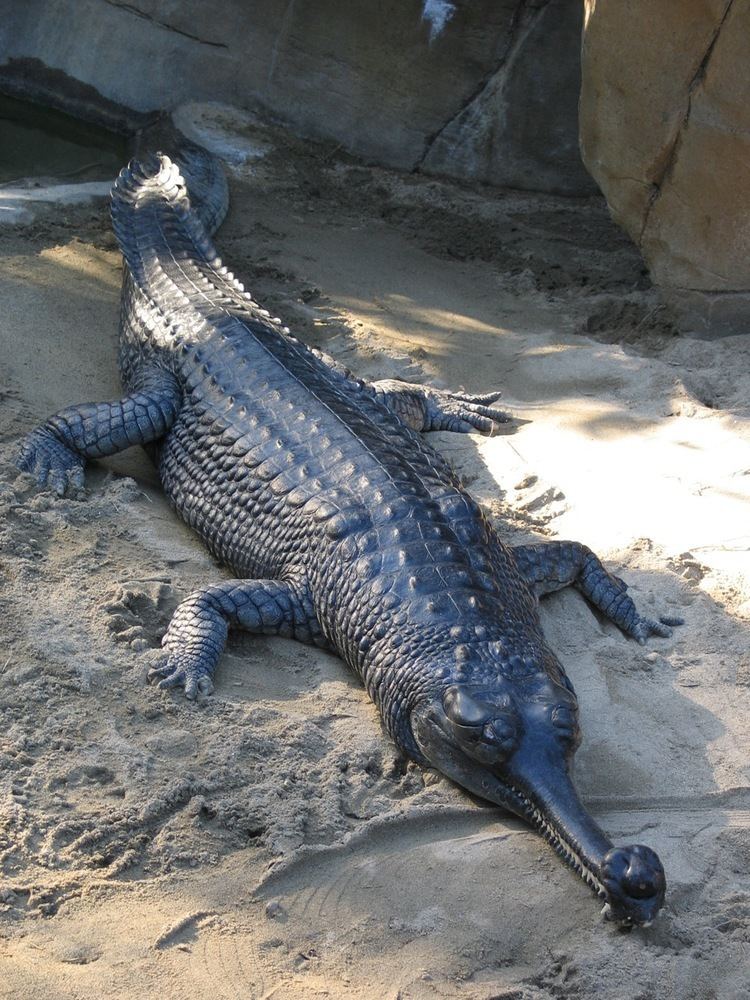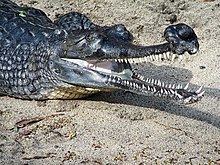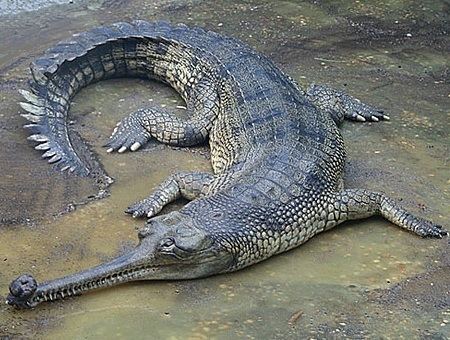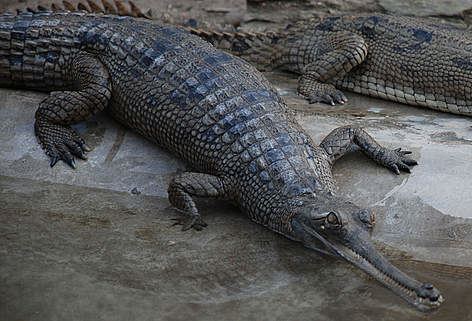Mass 160 – 250 kg (Adult) Clutch size 20 – 95 | Phylum Chordata Higher classification Gavialis Rank Species | |
 | ||
Length Male: 3 – 5 m (Adult), Female: 2.7 – 3.8 m (Adult) Similar Crocodiles, Reptile, Caiman, Mugger crocodile, Gavialidae | ||
Baby indian gharial crittacam
The gharial (Gavialis gangeticus), also known as the gavial, and the fish-eating crocodile, is a crocodilian of the family Gavialidae, native to the northern part of the Indian Subcontinent. The global wild gharial population is estimated at fewer than 235 individuals, which are threatened by loss of riverine habitat, depletion of fish resources, and entanglement in fishing nets. As the population has declined drastically in the past 70 years, the gharial is listed as Critically Endangered on the IUCN Red List.
Contents
- Baby indian gharial crittacam
- Gharial gavialis gangeticus
- Characteristics
- Distribution and habitat
- Ecology and behaviour
- Basking
- Feeding ecology
- Reproduction
- Threats
- Conservation
- In situ initiatives
- In captivity
- Evolution
- Taxonomy
- Palaeontological classification
- Vernacular names
- References

The gharial is one of the longest of all living crocodilians, measuring up to 6.25 m (20.5 ft), though this is an extreme upper limit, as the average adult gharial is only 3.5 to 4.5 m (11 to 15 ft) in size. With 110 sharp, interdigitated teeth in its long, thin snout, it is well adapted to catching fish, its main diet. The male gharial has a distinctive boss at the end of the snout, which resembles an earthenware pot known in Hindi as ghara. The gharial's common name is derived from this similarity.

Gharials once inhabited all the major river systems of the Indian Subcontinent, from the Irrawaddy River in the east to the Indus River in the west. Their distribution is now limited to only 2% of their former range. They inhabit foremost flowing rivers with high sand banks that they use for basking and building nests. They usually mate in the cold season. The young hatch before the onset of the monsoon.

The gharial is one of three crocodilians native to India, the other two being the mugger crocodile and the saltwater crocodile.

Gharial gavialis gangeticus
Characteristics
The gharial is characterised by its extremely long, thin jaws, which are regarded as an adaptation to a primarily piscivorous diet. Males reach up to 6 m (20 ft) with an average weight of around 160 kg (350 lb).

It is dark or light olive above with dark cross-bands and speckling on the head, body and tail. Dorsal surfaces become dark, almost grey-black, at about 20 years of age. Ventral surfaces are yellowish-white. The neck is elongated and thick. The dorsal ridges are more or less restricted to the median regions of the back. The fingers are extremely short and thickly webbed. Males develop a hollow bulbous nasal protuberance at the tip of the snout upon sexual maturity. The name gharial is derived from the resemblance of the nasal growth to an earthen pot known locally as 'ghara'. Gharials are the only extant crocodilian with visible sexual dimorphism. Although the function of the nasal boss is not well understood, it is apparently used as a visual sex indicator, as a sound resonator, or for bubbling or other associated sexual behaviours.
The average size of mature gharials is 3.5 to 4.5 m (11 to 15 ft). The largest recorded length is 6.25 m (20.5 ft), and the largest recorded weight is 977 kg (2,154 lb). Hatchlings approximate 37 cm (15 in). Young gharials can reach a length of 1 m (3.3 ft) in 18 months. The average body weight ranges from 159 to 250 kg (351 to 551 lb). Males commonly attain a total length of 3 to 5 m (9.8 to 16.4 ft), while females are smaller and reach a body length of up to 2.7 to 3.75 m (8.9 to 12.3 ft).
The elongated, narrow snout is lined by 110 sharp interdigitated teeth and becomes proportionally shorter and thicker as an animal ages. There are 27 to 29 upper and 25 or 26 lower teeth on each side. These teeth are not received into interdental pits; the first, second, and third mandibular teeth fit into notches in the upper jaw. The front teeth are the largest. The snout is narrow and long, with a dilation at the end and its nasal bones are comparatively short and are widely separated from the pre-maxillaries. The nasal opening of a gharial is smaller than the supratemporal fossae. The lower anterior margin of the orbit (jugal) is raised and its mandibular symphysis is extremely long, extending to the 23rd or 24th tooth. A dorsal plate is formed from four longitudinal series of juxtaposed, keeled, and bony scutes. The length of the snout is 3.5 (in adults) to 5.5 times (in young) the breadth of the snout's base. The nuchal and dorsal scutes form a single continuous plate composed of 21 or 22 transverse series. Gharials have an outer row of soft, smooth, or feebly keeled scutes in addition to the bony dorsal scutes. They also have two small post-occipital scutes. The outer toes are two-thirds webbed, while the middle toe is only one-third webbed. They have a crest on the outer edge of the forearm, leg, and foot. Typically, adult gharials have a dark olive colour tone, while the young are pale olive, with dark brown spots or cross-bands.
The well-developed, laterally flattened tail and webbed rear feet provide tremendous manoeuvrability in deepwater habitat. On land, however, an adult gharial can only push itself forward and slide on its belly. The laterally compressed tail serves both to propel the animal and as a base from which to strike at prey.
The three largest specimens reported were a 6.5-m gharial killed in the Gogra River of Faizabad in August 1920, a 6.3-m individual shot in the Cheko River of Jalpaiguri in 1934, and a giant of 7-m animal, which was shot in the Kosi River of northern Bihar in January 1924. Though specimens of over 6 m (20 ft) were not uncommon in the past, such large individuals are not known to exist today.
Distribution and habitat
Gharials once thrived in all the major river systems of the Indian Subcontinent, spanning the rivers of its northern part from the Indus River in Pakistan across the Gangetic floodplain to the Irrawaddy River in Myanmar. Today, they are extinct in the Indus River, in the Brahmaputra of Bhutan and Bangladesh, and in the Irrawaddy River. Their distribution is now limited to only 2% of their former range.
They are sympatric with the mugger crocodile (Crocodylus palustris) and formerly with the saltwater crocodile (Crocodylus porosus) in the delta of Irrawaddy River.
In 1977, four nests were recorded in the Girwa River of Katarniaghat Wildlife Sanctuary, where 909 gharials were released until 2006. Twenty nests were recorded in 2006, so 16 nesting females resulted from 30 years of reintroductions, which is equivalent to 2% of the total pre-2006 releases. This is seemingly not a great achievement for the money and effort spent, and as several researchers have suggested, perhaps carrying capacity has been reached there. In 1978, twelve nests were recorded in the Chambal River in the National Chambal Sanctuary, where 3,776 gharials were released until 2006. By 2006, nesting had increased by over 500% to 68 nests, but the recruited mature, reproducing females constituted only about 2% of the total number released. The newly hatched young are especially prone to being flushed downstream out of the protected areas during the annual monsoonal flooding.
Ecology and behaviour
Gharials are arguably the most thoroughly aquatic of the extant crocodilians: adults apparently do not have the ability to walk in a semi-upright stance as other crocodilians do, and can only move in a forward "sliding" motion on land. They are generally residents of flowing rivers with deep pools that have high sand banks and good fish stocks. Exposed sand banks are used for nesting.
Basking
Like other crocodilians, gharials are ectothermic (cold-blooded), and use sun basking to warm up and water to cool down. Despite the limited ability of terrestrial locomotion in the gharial, they bask on exposed sand banks (rarely on rocks) daily, except sometimes when there is rain. In parts of its range this species basks more than the mugger crocodile. Although gharials often bask in groups, each individual may have a preferred spot that it defends. During the cold season where the air temperature typically is about 18 °C (64 °F) and the water about 17 °C (63 °F) basking occurs throughout the day. During the warm season where the air temperature typically is about 35 °C (95 °F) and the water about 25 °C (77 °F) gharials bask less and avoid midday basking.
Feeding ecology
Their elongated, narrow snout reduces resistance to water when hunting fish, while the very sharp interdigitated teeth are well adapted for capturing them. Young gharials eat insects, tadpoles, small fish and frogs. Adults feed on fish and small crustaceans. Their jaws are too thin and delicate to grab larger prey, especially people. They catch fish by lying in wait for fish to swim by, and then catch the fish by quickly whipping their heads sideways and grabbing it in their jaws. They herd fish with their bodies against the shore, and stun fish using their underwater jaw clap. They do not chew their prey, but swallow it whole. Young gharials forage and hide in shallow water. With body size increasing, they forage in deeper water. Gharials up to 120 cm (47 in) prefer 1–3 m (3.3–9.8 ft) deep water, those up to 180 cm (71 in) hunt and hide in 2–3 m (6.6–9.8 ft) deep water. Adult gharials prefer water deeper than 4 m (13 ft) for foraging and hiding.
Gharials do not kill and eat humans. Jewellery found in their stomachs may have been the reason for the myth that gharials are man-eaters. They may have swallowed this jewellery as gastroliths used to aid digestion or buoyancy management.
Reproduction
Males mature at around 13 years old, which is when the ghara begins to grow on the snout. They advertise for mates by making hissing and buzzing noises as they patrol their territories, and may have a harem of females within a territory which they aggressively defend from other males. Females communicate their readiness to mate by raising their snouts upwards. During courtship, males and females follow prospective mates around until a suitable mate is chosen. Courtship also involves head and snout rubbing and mounting by both males and females.
Gharials usually mate during December and January. During the dry season in March and April, they dig nests in a riverside sand or silt bank, 1–5 m (3.3–16.4 ft) away from the waterline. Using their hind feet, they dig 50–60 cm (20–24 in) deep holes, in which the female lays 20–95 eggs. The eggs are the largest of any crocodilian species and weigh an average of 160 g. After 71 to 93 days of incubation, young gharials hatch in July just before the onset of the rainy season. Their sex is most likely determined by temperature, like in other crocodilians too. Female gharials dig up the young in response to hatching chirps, but do not assist the hatchlings to reach the water. They guard the hatchlings for some time.
Threats
The gharial population is estimated to have declined from 5,000-10,000 individuals in 1946 to fewer than 235 individuals alive in 2006, a decline of 96–98% within three generations. They were killed by fishermen, overhunted for skins, trophies and indigenous medicine, and their eggs collected for consumption. Today, the remaining individuals form several fragmented subpopulations. Hunting is no longer considered a significant threat. However, the wild population of gharials declined by about 58% between 1997 and 2006 because:
In December 2007, several gharials were found dead in the Chambal River. Initially, it was suspected that fishermen illegally had caught fish using nets, in which gharials became trapped and subsequently drowned. Later post mortem pathological testing of tissue samples from the dead gharials revealed high levels of heavy metals such as lead and cadmium, which together with stomach ulcers and protozoan parasites reported in most necropsies were thought to have caused their deaths.
Conservation
The gharial is listed on CITES Appendix I.
By 1976, the estimated total population of wild gharials had declined from what is thought to have been 5,000-10,000 in the 1940s to less than 200, a decline of about 96%. The Indian government subsequently accorded the species protection under the Wildlife Protection Act of 1972.
In 1997, the total wild population was estimated at 436 adult gharials that had declined to 182 in 2006. This drastic decline has happened within a period of nine years, well within the span of one generation, and qualifies the gharial for Critically Endangered listing by the IUCN. Estimates from population surveys carried out in 2007 indicated 200–300 wild breeding adults left in the world.
In situ initiatives
Conservation programs have been undertaken in India and Nepal, based on the establishment of protected areas and restocking these with animals born in captivity, but nowhere has restocking re-established viable populations. Juvenile gharials were released into largely inhospitable habitats in Indian and Nepali rivers and left to their fate. Reintroduction did not work so well, largely due to growing and uncontrolled anthropogenic pressures, including depletion of fish resources. Monitoring has not been consistently carried out, and little research on adaptation, migration and other key aspects has been conducted.
Project Crocodile began in 1975 under the auspices of the Government of India with the aid of the United Nations Development Fund and Food and Agriculture Organization. The project included an intensive captive breeding and rearing program intended to restock habitats with low numbers of gharials. An acute shortage of gharial eggs was overcome by their purchase from Nepal. A male gharial was flown in from the Frankfurt Zoo to become one of the founding animals of the breeding program. Sixteen crocodile rehabilitation centers and five crocodile sanctuaries including the National Chambal Sanctuary and Katerniaghat Wildlife Sanctuary were established in India between 1975 and 1982. By 2004, 12,000 gharial eggs had been collected from wild and captive-breeding nests, and over 5,000 gharials reared to about a meter or more in length and released into the wild. But in 1991, funds were withdrawn for the captive-breeding and egg-collection programs. In 1997–1998, over 1,200 gharials and over 75 nests were located in the National Chambal Sanctuary, but no surveys were carried out between 1999 and 2003.
In December 2010, the then Indian Minister for Environment and Forests, Jairam Ramesh, visited the Madras Crocodile Bank with Romulus Whitaker, and announced the formation of a National Tri-State Chambal Sanctuary Management and Coordination Committee for gharial conservation on 1,600 km2 (620 sq mi) of the National Chambal Sanctuary along the Chambal River in Madhya Pradesh, Rajasthan and Uttar Pradesh. The committee will comprise representatives of three states' Water Resources Ministries, states' Departments of Irrigation and Power, Wildlife Institute of India, Madras Crocodile Bank Trust, the Gharial Conservation Alliance, Development Alternatives, Ashoka Trust for Research in Ecology and the Environment, Worldwide Fund for Nature, and the divisional forest officers of the three states. The committee will plan strategies for protection of gharials and their habitat, involving further research on gharial ecology and socioeconomic evaluation of dependent riparian communities. Funding for this new initiative will be mobilized as a subscheme of the ‘Integrated Development of Wildlife Habitats’ in the yearly amount of 50–80 million Indian rupees (US$1 million to 1.7 million) for five years.
In captivity
Gharials are bred in captivity in the National Chambal Sanctuary in Uttar Pradesh, and in the Gharial Breeding Centre in Nepal's Chitwan National Park, where they are generally grown for two to three years and average about one metre in length, when released.
In India, they are also kept in the Madras Crocodile Bank Trust, Indira Gandhi Zoological Park, Jawaharlal Nehru Biological Park in Bokaro Steel City, Bannerghatta Zoo in Bangalore, Junagadh Zoo, ChattBir Zoo in Chandigarh and Biological Park Itanagar. The National Zoological Gardens of Sri Lanka and the Singapore Zoo each keep a breeding pair. The Japanese Nogeyama Zoo keeps two females. In Europe, they are kept in the Prague Zoo and a few other zoos. In the United States they are kept in the Honolulu Zoo, the Cleveland Metroparks Zoo, the Fort Worth Zoo, the San Diego Zoo, the National Zoological Park, the San Antonio Zoo and Aquarium, and in the St. Augustine Alligator Farm.
The French crocodile farm La Ferme aux Crocodiles received six juveniles in May 2000 from the Gharial Breeding Centre in Nepal.
The Lahore Zoo in Pakistan keeps breeding pairs. The Kukrail Reserve Forest near Lucknow keeps gharials.
Evolution
The earliest gharial may have been related to the modern types. Some died out at the same time as the dinosaurs at the end of the Cretaceous, others survived until the early Eocene. The modern forms appeared at much the same time, evolving in the estuaries and coastal waters of Africa, and crossing the Atlantic to reach South America as well. The discovery of the fossil remains of the Puerto Rican gharial Aktiogavialis puertorisensis in a cave located in San Sebastián, Puerto Rico, suggested that the Caribbean served as the link between the two continents.
Gharials have sacrificed the great mechanical strength of the robust skull and jaw that most crocodiles and alligators have, and consequently are unable to prey on larger creatures. The reduced weight and water resistance of their lighter skull and very narrow jaw enables gharials to catch rapidly moving fish, using a side-to-side snapping motion. At their peak, the Gavialoidea were numerous and diverse; they occupied much of Asia and America up until the Pliocene. One species, Rhamphosuchus crassidens of India, is believed to have grown to an enormous 15 metres (~50 feet) or more.
Taxonomy
The gharial and its extinct relatives are grouped together by taxonomists in several different ways:
According to molecular genetic studies the gharial and the false gharial (Tomistoma) are close relatives, which would support to place them in the same family. Furthermore, molecular studies consistently and unambiguously show the Gavialidae to be a sister group of the Crocodylidae to the exclusion of Alligatoridae, rendering Brevirostres paraphyletic and Gavialoidea perhaps polyphyletic. The clade including crocodiles and gharials has been suggested to be called Longirostres.
Palaeontological classification
Vernacular names
Common names include gavial del Ganges, long-nosed crocodile, bahsoolia, chimpta, lamthora, mecho kumhir, naka, nakar, shormon, thantia, thondre.
